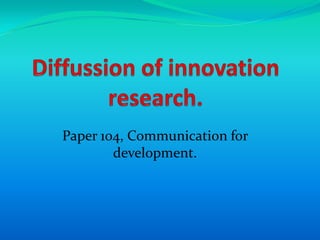Diffussion of innovation research
•Transferir como PPTX, PDF•
1 gostou•1,150 visualizações
Denunciar
Compartilhar
Denunciar
Compartilhar

Recomendados
Recomendados
Mais conteúdo relacionado
Mais procurados
Mais procurados (20)
Diffusion%20of%20 innovation%20 %20lecture%20with%20characteristics%20and%20p...

Diffusion%20of%20 innovation%20 %20lecture%20with%20characteristics%20and%20p...
McNeill (2007) Diffusion Of Innovation Notes (Draft 01)

McNeill (2007) Diffusion Of Innovation Notes (Draft 01)
Semelhante a Diffussion of innovation research
17 cb diffusion of innovations 201517 cb diffusion of innovations 2015

17 cb diffusion of innovations 2015Rajesh Satpathy, Regional College of Management (RCM), Bhubaneswar
Semelhante a Diffussion of innovation research (20)
How should the concept of diffusion of innovations theory be applied

How should the concept of diffusion of innovations theory be applied
Technology & Innovation Management Course - Session 1

Technology & Innovation Management Course - Session 1
Discuss the concept that attitude and opinion change were consider.docx

Discuss the concept that attitude and opinion change were consider.docx
Último
Último (20)
Collective Mining | Corporate Presentation - May 2024

Collective Mining | Corporate Presentation - May 2024
Corporate Presentation Probe Canaccord Conference 2024.pdf

Corporate Presentation Probe Canaccord Conference 2024.pdf
Nicola Mining Inc. Corporate Presentation May 2024

Nicola Mining Inc. Corporate Presentation May 2024
Financial Results for the Fiscal Year Ended March 2024

Financial Results for the Fiscal Year Ended March 2024
Osisko Gold Royalties Ltd - Corporate Presentation, May 2024

Osisko Gold Royalties Ltd - Corporate Presentation, May 2024
Osisko Development - Investor Presentation - May 2024

Osisko Development - Investor Presentation - May 2024
Diffussion of innovation research
- 1. Paper 104, Communication for development.
- 2. The outline: The subject-matter. The advent of diffusion studies. How it works. Everett Roger’s S-shaped curve. The bell shape curve of adopters. The innovation decision/adoption process. Common scope of diffusion research. Purpose of diffusion research.
- 3. The subject matter: Diffusion is the process by which an innovation is communicated through certain channels over time among members of a social system. An innovation is an idea, practice, or object perceived as new by an individual or other unit of adoption. Messages concerned with new ideas are disseminated among the people so that the modern innovative ideas or products are easily accepted. Diffusion research revolves round the conditions which increase or decrease the likelihood that a new idea, product, or practice will be adopted by members of a given culture.
- 4. The advent of diffusion studies: First studied by the French sociologist Gabriel Tarde in 1903 and by German and Austrian anthropologists such as Friedrich Ratzel and Leo Frobenius. In the year 1962 Everett Rogers, took into consideration the research from over 508 diffusion studies and produced a theory for the adoption of innovations among individuals and organizations. Everett Rogers identified six traditions that impacted diffusion research: anthropology, early sociology, rural sociology, education, industrial, and medical sociology.
- 5. How it works: Rogers proposed 4 main elements that influence the spread of a new idea: the innovation, communication channels, time, and a social system. Diffusion is the process by which an innovation is communicated through certain channels over time. Individuals progress through 5 stages: knowledge, persuasion, decision, implementation, and confirmation. It spreads via various communication channels and during communication, the idea is generally processed basing on the perceptions of the innovation which further influences diffusion.
- 6. Everett Rogers S-shaped curve The S shaped curve indicates the adoption of an innovation over time. The curve has a typical S-shape. Initially only a few innovators and early adopters are prepared to experiment with new techniques: about 16% of the population. As the idea gains ground, the majority—the next 68%—accept the innovation. Finally, the laggards take notice.
- 7. The bell shape curve of adopters: Consumers can be grouped according to how quickly they adopt a new product. Diffusion studies convey that adopter categories of a particular product can be divided into: (1) innovators, (2) early adopters, (3) early majority, (4) late majority, and (5) laggards.
- 8. The innovation decision and adoption process
- 9. Common scope of diffusion research The characteristics of an innovation which may influence its adoption. The decision-making process that occurs when individuals consider adopting a new idea, product or practice. The characteristics of individuals that make them likely to adopt an innovation. The consequences for individuals and society of adopting an innovation. Communication channels used in the adoption process.
- 10. Purpose of diffusion research To depict the successive increase in the number of adopters over time. Permits prediction of the continued development of the diffusion process. Facilitates a theoretical explanation of the dynamics of the diffusion process.
